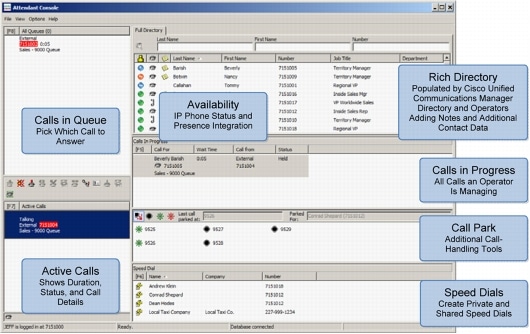Cisco Unified Attendant Console Department Edition Version 9.1 Data Sheet
Available Languages
Cisco® Unified Attendant Consoles are client-server applications that enable operators and receptionists to answer and quickly dispatch incoming calls to their intended recipients or suitable alternatives. The applications offer a rich set of features, including a call-queuing engine, endpoint busy status, presence integration, and Cisco Unified Communications Manager end-user directory search.
Product Overview
Figure 1. Cisco Unified Attendant Console Department Edition

Features and Benefits
Table 1. Features and Benefits of Cisco Unified Attendant Console Department Edition
| Feature |
Benefit |
| Queue Features |
|
| Support for one queue per department |
This feature allows the department administrator to receive and screen calls. |
| Queue operator views |
Department administrators can view all calls within the queue. If they see many calls in queue, they know that they need to quickly process callers. If there are few calls in queue, they can spend more time with each caller to provide a higher level of customer service. |
| Overflow options |
Number of Calls overflow sends calls to the overflow destination when the queue already contains the maximum capacity of calls. No Operator overflow sends calls to the overflow destination when no operators are logged into the queue. Overflow settings are defined on a queue-by-queue basis. |
| Directory Features |
|
| Support for up to 150 IP phone users per department |
Department administrators can answer calls and view busy status for up to 150 IP phone users. |
| Directory integration |
Each department configured on the Cisco Unified Attendant Console Department Edition server derives its directory from the Cisco Unified Communications Manager directory. The application includes a utility for keeping the directories synchronized. |
| Search options |
Three directory search fields are provided. They allow the department administrator to quickly find call destinations and handle calls effectively. Search options include last name, first name, and extension. |
| Presence integration |
The department administrator can view each contact's Cisco Unified Presence status directly from the Attendant Console directory. This feature allows operators to manage calls efficiently because they can easily see whether a particular contact is available to take a call. Microsoft OCS 2007 and Microsoft Lync are also supported presence sources in the Attendant Console directory. |
| Telephony Features |
|
| Operator handset ringing |
When a call comes into a department configured with operator handset ringing, the call is sent directly to the handset of the department administrator logged into that department for the longest duration. This feature enables department administrators to answer the call from a wireless headset while away from their desks. (The wireless headset is not included.) |
| Transfer reversion (call recall) |
This feature allows a transferred call to revert back to the department administrator so that it can be answered and then transferred to a new destination. |
| Call park |
With call park, a caller can be placed on hold while the department administrator announces that a call is on hold and waiting for a particular person or group. The call can be answered from any phone by dialing the park extension. |
| Call park recall |
If a parked call is not answered, this feature allows that call to revert back to the department administrator so that it can be transferred to a new destination. |
| Call toggle |
This feature allows the department administrator to shift between callers. |
| Conference |
This feature allows the department administrator to provide a three-party conference call. |
| Additional Features |
|
| Adjustable font size |
Changing the font size is one of the many ways in which individual users can tailor the Cisco Unified Attendant Console Department Edition application to best suit their needs. |
| Server-based console preferences |
Many of the attendant console client preferences can now follow users to different PCs running Cisco Unified Attendant Console Department Edition. |
| VMware support |
Cisco Unified Attendant Console server is supported in a production environment on VMware ESXi 4.x or 5.0 running on a host machine that is compliant with the Cisco Specifications-Based Hardware Support program. For more information about this program, please visit: http://docwiki.cisco.com/wiki/Specification-Based_Hardware_Support. Note: This feature is supported only with Cisco Unified Communications Manager 8.0(1) and later. |
| Support for five departments per server |
You can make the most of your hardware or virtual machines by serving up to five departments on a single Cisco Unified Attendant Console Department Edition server. |
| Accessibility |
The visually impaired can use the Cisco Unified Attendant Console Department Edition because both ZoomText and JAWS scripts are supported. |
| Attendant console client localization |
English, French, German, Italian, Portuguese, Spanish, Dutch, Swedish, Danish, Russian, Arabic, Korean, Japanese, Traditional Chinese, and Simplified Chinese are supported. |
Product Specifications
Table 2. Server Requirements for Cisco Unified Attendant Console Department Edition
Note: The operator client for the Cisco Unified Attendant Console Department Edition requires the PC specifications listed in Table 3. You can install Cisco Unified Attendant Console Department Edition client software on many PCs, but you can create only up to two department administrator (operator) logins for each department. Refer to the "Ordering Information" section for additional licensing details.
Table 3. Client Requirements
Download Information and 60-Day Evaluation
Ordering Information
Table 4. Ordering Information
Cisco Unified Communications Services and Support
For More Information
 Feedback
Feedback